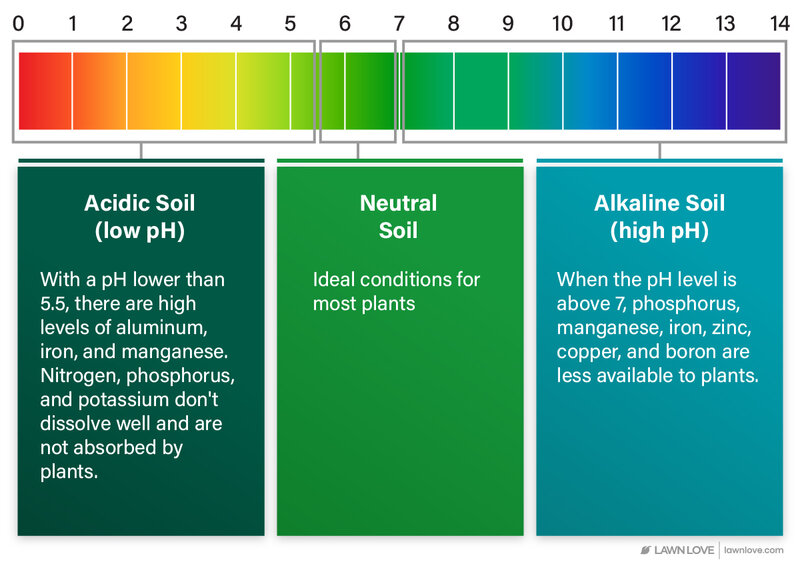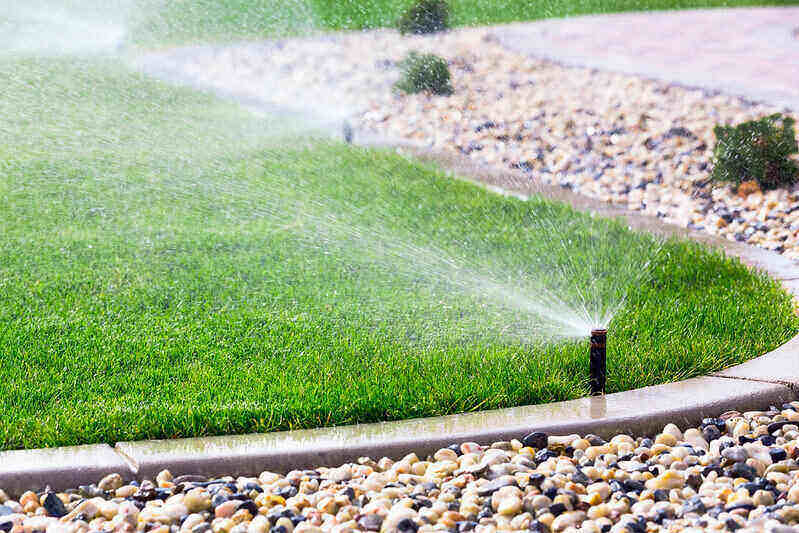
When the earth is thawing and buds are blooming, it’s time to get your Toledo lawn ready for spring growth. Simple tasks are high on the list, such as raking the turf and testing the soil. But you can delay big jobs until autumn, like dethatching and aeration.
Here in the Glass City, we can’t forget how our lawn care impacts Lake Erie. We’ve sprinkled eco-friendly lawn care tips throughout this guide so you can help protect your Great Lake.
1. Rake deeply
Just like you need your morning coffee, your grass needs a little pick-me-up after its long winter slumber. A deep comb with a leaf rake should do the trick. Raking:
- Loosens matted grass to promote new growth and air circulation
- Collects leaves and twigs harboring fungi and pests
- Minimizes thatch buildup
What’s thatch? Thatch is the layer of living and dead organic matter that builds up between the soil’s surface and the grass blades. A thin thatch layer is healthy for your lawn because it acts as mulch. But a layer that’s a half-inch or thicker makes excellent real estate for disease and pests.
2. Treat any lingering lawn diseases or pest
Did a mole move into your lawn over winter break? Is your grass growing snow mold? Spring is the perfect time to treat your lawn for fungal diseases and uninvited guests. If you don’t control the problem immediately, the disease or pest will weaken your turf and make it ill-equipped for summer stress.
Here are some common lawn diseases to keep an eye out for this spring:
- Pink snow mold
- Gray snow mold
- Dollar spot
- Anthracnose
- Leaf spot and melting-out
- Red thread
- Rust
- Fairy Ring
And here are some spring pests to send packing:
- Fire ants
- Grubs
- Moles
- Gophers
- Voles
3. Test the soil

If you’ve never tested your soil before, let’s start the year on the right foot. Testing your soil helps you determine the best fertilizer and amendments to apply to your lawn so you can have happy, healthy grass.
A soil test reveals:
- Nutrient deficiencies in the soil
- Salt levels
- Organic matter percentage
- pH imbalances
- Recommended fertilizers and soil amendments that will enhance turf growth and soil health
At-home soil tests are available, but they don’t provide as detailed results as a lab soil test. The Ohio State University Extension offers tips on collecting a soil sample, preparing it for submission, and where to send it.
For your next lab soil test, consider testing in the fall. Homeowners, gardeners, and farmers often sample their soil in spring, which means you’ll have a much faster turnaround if you test in the fall when demand for lab testing is lower.
Test your soil once every three years.
Eco-friendly soil test tip
Without the help of a soil test, it’s easy to give your lawn more fertilizer than it needs. Excess fertilizer can enter our water systems (like Lake Erie) and cause harmful algal blooms.
4. Fertilize (only if necessary)
If you only fertilize your lawn once a year, fall is the best time to fertilize Toledo lawns. If your turf needs two fertilizer applications per year, late spring is the second-best time to fertilize.
If you’re fertilizing your lawn in late spring, do so after your grass has had its early spring green-up. If you fertilize too early, the grass will grow too fast and sacrifice its root growth for leaf growth. Deep root growth is essential for a healthy lawn.
Refer to your soil test to determine the adequate fertilizer levels your soil needs and whether your soil requires one, two, or more applications per year.
Eco-friendly fertilizer tips
Toledoans are no strangers to the effects of algal blooms. Lake Erie suffered from an algal blooms that caused Toledo’s 2014 drinking water crisis.
Fertilizer is packed with phosphorus and nitrogen, two significant contributors to algal blooms. The stormwater runoff that flows through your yard carries with it the lawn’s excess fertilizer. The toxic rainwater drains into local waterways and pollutes the ecosystem with phosphorus and nitrogen.
So how can you fertilize your lawn with Lake Erie in mind? Here are some tips:
- Keep your lawn well maintained. A healthy, established lawn usually won’t need more than one fertilizer application per year.
- Conduct a soil test so that you can measure the precise amount of fertilizer your lawn needs. It’s easy to overestimate fertilizer when you don’t know your soil’s fertility levels.
- Consider using organic fertilizers. Most organic fertilizers are more eco-friendly than synthetic fertilizers.
5. Turn on the irrigation system

If you winterized your irrigation system in the fall, spring is the time to get the water running again. The soil is warming up, which means your grass is ready to quench its thirst.
Whether you water your lawn via an underground drip irrigation system, above-ground sprinklers, or garden hose, here are some watering tips to keep in mind this spring:
- Most established lawns need 1 to 1 ½ inches of water per week. This amount will vary depending on many factors, including local rain levels, air temperatures, and your lawn’s grass type.
- Watering less often and for long periods promotes a deep and healthy root system. Watering too often and for short periods encourages a shallow and weak root system.
- The best time of day to water your lawn is before 10 a.m., but preferably before 8 a.m. If you water after 10 a.m., the sun will evaporate the water before your lawn has a chance to absorb it.
- Avoid watering in the evenings. Although the sun evaporates water, the lawn does need the sun to help it dry. If you water in the evenings, the yard will remain moist for long hours and create an environment that’s attractive to pests and disease.
Eco-friendly watering tips
The rise of polluted water systems, climate change, and water shortages has made water conservation critical. According to the Environmental Protection Agency, landscape irrigation totals approximately 9 billion gallons of water per day nationwide. That’s a lot of water spent on our lawns.
Here are three ways to conserve irrigation water:
- Not only can a rain barrel save water, but it also helps minimize stormwater runoff and saves on energy costs.
- Consider installing an underground drip irrigation system if you’re renovating your landscape. Unlike a sprinkler system or hose that loses water through evaporation or runoff, a drip irrigation system delivers water underground directly to the roots.
- Replace parts of the lawn with drought-tolerant ground covers, a rock garden, or xeriscape.
6. Apply pre-emergent herbicide
Show those summer weeds who’s boss with a pre-emergent herbicide. Apply your pre-emergent herbicide when soil temperatures are around 55 degrees Fahrenheit for at least 48 hours. Always refer to the product’s instructions before applying herbicides.
Eco-friendly herbicide tip
Like fertilizer, herbicides contribute to polluted runoff and algal blooms. The healthier your lawn, the easier it will outcompete weeds, which means less need for herbicides.
On the other hand, if you have an unhealthy lawn, you’ll need to rely more on herbicides to block out weeds. By keeping your lawn healthy and well maintained, you can help minimize herbicide use.
If weeds do happen to pop up in your yard, you have the option to remove them naturally, such as pulling or digging them out.
7. Rev up the lawn mower
The nice thing about winter is that you can take a break from lawn mowing. Now that spring is here, it’s time to rev up the engine.
Before you cut your grass, ensure your mower blades are sharp. A dull blade will rip your grass instead of cleanly cutting it. Keeping your lawn manicured in spring will help ward off summer pests and diseases.
Another mowing tip to follow is the rule of one-third. Cutting off more than one-third of the turf’s length in a single mow is unhealthy for your lawn. For example, if your grass is 3 inches tall, don’t remove more than 1 inch.
Eco-friendly mowing tip
If you’re mowing your lawn with a gas mower, make the switch to a battery-powered or corded electric mower to help lower your carbon footprint.
This lawn care season, less is more
Having been cooped up all winter long, you might be eager to resume lawn care chores and catch up on your vitamin D. But remember: Don’t do any invasive treatments on your cool-season grass; otherwise, you might stress your lawn before summer.
Chores like aeration, dethatching, and fertilization can all be performed in the fall (saving these treatments for fall will help the lawn recover from summer stress). Springtime is perfect for testing the soil, removing snow mold, and performing the first mow of the year.
Hire a pro for a healthier lawn
Want to make a difference for your local ecosystems? Start with your lawn care routine. A healthy lawn requires fewer fertilizers, pesticides, fungicides, and herbicides to survive, which means less algal growth in local bodies of water.
But keeping up with your lawn’s health can be pretty time-consuming. And if you’re not a lawn care expert, you might not know what’s best for your soil or grass type. Hire a lawn care professional who can tackle the mowing, edging, and trimming for you. They’ll keep your lawn healthy so you can spend your time doing what matters most in the city you love.
Main Photo Credit: Bennilover | Flickr | CC BY-ND 2.0

